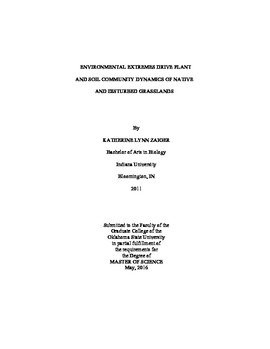| dc.contributor.advisor | Wilson, Gail | |
| dc.contributor.advisor | Thickman, Karen R. | |
| dc.contributor.author | Zaiger, Katherine Lynn | |
| dc.date.accessioned | 2017-02-22T22:17:00Z | |
| dc.date.available | 2017-02-22T22:17:00Z | |
| dc.date.issued | 2016-05-01 | |
| dc.identifier.uri | https://hdl.handle.net/11244/49188 | |
| dc.description.abstract | Environmental drivers such as precipitation and temperature are important predictors of changes in plant community composition. Anthropogenic disturbances also alter plant composition, often leading to the invasion by non-native plant species. Global climate change will lead to more extreme changes in environmental factors, therefore, it is important to understand how both native and disturbed plant communities will respond to rapid changes in important drivers like precipitation and temperature. We looked at the response of plant and soil community dynamics by conducting a greenhouse experiment and by modeling current plant community responses to the environment using field observations. Our greenhouse experiment examined the plant and soil feedback (PSF) response of both cool- and warm-season native and non-native grasses to elevated temperatures (ambient and +5� C) and drought (100% and 75% field capacity). We also used linear modeling and AICc weighted model averaging to determine the relationships between plant species richness and several environmental variables (annual precipitation, annual evapotranspiration, and annual mean, maximum, and minimum temperature) in both native and disturbed sites across an east-west gradient across the tallgrass prairie region. In the greenhouse study, we found that experimental increases in temperature and drought had a significant influence on the direction and strength of native and non-native PSF response compared the PSF response under ambient conditions. Our modeling data show significant linear correlations between plant species richness and temperature-related drivers in disturbed sites. However, linear models best explained plant species richness of native sites as precipitation, while results from AICc weighted model averaging indicated that the interaction between temperature and precipitation was the strongest driver of plant community composition. Understanding how climate drives plant community composition will become more urgent under climate change predictions, and our results suggest that future environmental models used to predict plant community changes should incorporate interacting terms. Our results also emphasize the importance of native plant influence on PSFs under warmer and dryer conditions in community resilience to non-native invasion. | |
| dc.format | application/pdf | |
| dc.language | en_US | |
| dc.rights | Copyright is held by the author who has granted the Oklahoma State University Library the non-exclusive right to share this material in its institutional repository. Contact Digital Library Services at lib-dls@okstate.edu or 405-744-9161 for the permission policy on the use, reproduction or distribution of this material. | |
| dc.title | Environmental Extremes Drive Plant and Soil Community Dynamics of Native and Disturbed Grasslands | |
| dc.contributor.committeeMember | Bever, James D | |
| dc.contributor.committeeMember | Watters, Craig E | |
| osu.filename | Zaiger_okstate_0664M_14591.pdf | |
| osu.accesstype | Open Access | |
| dc.description.department | Natural Resources and Ecology Management | |
| dc.type.genre | Thesis | |
| dc.type.material | text | |
